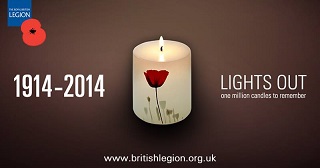 One hundred years ago, on 4th August 1914, Britain declared war on Germany, joining the conflict that became known as the Great War, the First World War and World War One. In the period 2014-2019 we will be commemorating some of the key anniversaries from WW1, both the military actions and some aspects of the war effort back in Britain.
One hundred years ago, on 4th August 1914, Britain declared war on Germany, joining the conflict that became known as the Great War, the First World War and World War One. In the period 2014-2019 we will be commemorating some of the key anniversaries from WW1, both the military actions and some aspects of the war effort back in Britain.
Three major events yesterday formed the first element of the commemoration period.
In Scotland a service at Glasgow Cathedral gave a particular focus to the contribution of Commonwealth nations in support of Britain throughout the war. The service included a personal response from one Scottish student who had visited the battlefields of Flanders with a school group.
At St.Symphorien military cemetery in Belgium international leaders gathered to mark the start of WW1, close to the town of Mons where the first major battle involving the British Expeditionary Force took place.
At Westminster Abbey in London the day concluded with a service and candle-lit vigil. A BBC news story covers some of the day’s activity.
Across the UK a special “Lights Out” initiative led by the Royal British Legion marked the start of the war. It was inspired by remarks made on 4th August 1914 by the British Foreign Secretary, Sir Edward Grey, about Europe entering a period of darkness. Many public buildings were darkened to support this very visual reminder.
Further actions are taking place all over the country, and show a variety of creative responses to the desire for respectful commemoration. For example, a field of ceramic poppies at the Tower of London, and a beacon of white light in Westminster. A cultural programme titled ’14-18 Now’ is supporting contemporary artists to reflect on the First World War and its meaning for the public today.
The lead-up to war, sparked by the assassination of Austrian Archduke Franz Ferdinand by a Serbian nationalist in June 1914, was a period of weeks during which the combatant nations failed to achieve a diplomatic solution to the crisis. Both sides in the war had complicated sets of treaties between nations for mutual support in case of war. The German Army’s invasion of Belgium, as a prelude to an attack on France, brought Britain into the conflict through a treaty to protect Belgian neutrality. The alliances ensured that huge numbers of people were drawn into the war by their governments, both as military combatants and on the Home Fronts. Another consequence was that the war was a global one, with fighting in many countries and on the seas, and campaigns involving troops from many nations.
Scottish regiments and divisions were a key component of many campaigns throughout the war, not solely the fighting on the Western Front in Belgium and France. Scots were also well-represented in the Royal Navy and Merchant navy war effort.
Many new resources are coming online to tell parts of the history of WW1 and its impacts at home and overseas. We will use this blog to highlight assets, stories and activities which will be of particular use to teachers and learners.
